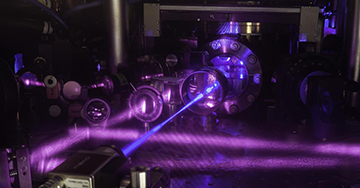
In JILA’s 3-D quantum gas atomic clock, three pairs of laser beams create a 3-D optical lattice that packs in a dense array of strontium atoms. A blue laser beam excites a cube-shaped atom array; the clock signal is read in fluorescence from the excited atoms. [Image: G.E. Marti/JILA]
A research team led by OSA Fellow Jun Ye of the U.S. National Institute of Standards and Technology (NIST) has devised an optical lattice clock that has reportedly achieved a record measurement precision of 3.5 × 10–19, a level that Ye characterizes as “a significant improvement” relative to previously demonstrated designs (Science, doi: 10.1126/science.aam5538). The team achieved the trick by engineering a 3-D optical lattice that packs in a dense array of strontium atoms, cooled to become a degenerate Fermi gas.
The configuration, according to the researchers, suppresses the atom–atom interactions that have held back further potential gains in clock precision and stability. That, in turn, raises the prospect of a new generation of atomic clocks—one in which researchers enlist the aid of very large ensembles of atoms to boost clock stability and performance.
Atom–atom interactions
Optical lattice clocks work by trapping large numbers of slow-moving laser-cooled atoms, such as 87Sr, within an optical lattice—essentially a standing wave created by tightly focused laser beams. The atoms can then be laser-excited into a well-constrained electronic transition that’s detected through laser fluorescence and that forms the “tick” of the clock. Most optical lattice clocks use a 1-D arrangement of atoms, and that configuration has been sufficient to achieve measurement precisions on the order of 10–18 and instabilities as low as the area of 10–16/τ½ (where τ is the time, in seconds, over which the clock’s performance is averaged).
But even as 1-D clocks have reached these jaw-dropping levels of precision and stability, they’ve run into a fundamental problem in pushing the needle further. The best way to increase a clock’s stability, and thus its precision, is to beef up the number of atoms in the lattice. But as the number of atoms that constitute the clock increases, interactions between the atoms themselves can lead to frequency shifts in the signal coming out of it, degrading the clock’s overall accuracy.
A 3-D view
Ye, who works at the JILA facility jointly run by NIST and the University of Colorado, Boulder, found a way around this conundrum by changing the geometry of the lattice from 1-D to 3-D. Using a 3-D lattice, his team was able to take advantage of the properties of a degenerate Fermi gas—a phase of matter first created by a JIST colleague, the late Deborah Jin, nearly two decades ago.
For a 3-D atomic clock, a degenerate Fermi gas—a so-called quantum gas consisting of fermionic particles such as 87Sr atoms—offers a number of advantages. For one, it’s a strongly correlated system of many particles, yet one whose state can be controlled as if it were a single particle. Another is that, in a 3-D lattice, the strongly repulsive atoms in a degenerate Fermi gas occupy what’s known as the Mott insulating regime, a state that prevents more than one atom from occupying any one node in the optical lattice.
That single-occupancy characteristic reduces the accuracy-sapping potential of interactions between the individual atoms in the lattice. And, with atomic interactions minimized, it’s possible to boost the density of atoms in the clock, and hence its achievable stability, by orders of magnitude, according to the team.
Toward further stability increases
Ye’s team put those ideas into practice in an experiment in which the researchers laser-cooled an ensemble of 87Sr atoms down to Fermi temperature to produce a two-spin Fermi gas, and packed the atoms into a 3-D optical lattice created by three pairs of laser beams. The Mott insulating behavior allowed the team to build a lattice with a density of 1013 atoms/cm3—three orders of magnitude greater than in previous optical-lattice experiments, according to the authors.
Putting the new clock through its paces, Ye’s team found that, in 2.2 hours of averaging, the clock achieved an instability of only 3.1 × 10–17/τ½, which corresponded to a measurement precision of 3.5 × 10–19—an order-of-magnitude improvement over 1-D clocks. And the researchers believe that lattice configurations with a larger beam waist, which can thereby accommodate larger numbers of atoms, could hammer down instabilities still further, to the area of perhaps 10–18/τ½.
What will such ultrastable clocks be good for? In addition to pushing forward GPS accuracy, new definitions of measurement standards, and other commonly cited applications for precision metrology, Ye and colleagues have suggested another one, in a paper last year published in Physical Review D (doi: 10.1103/PhysRevD.94.124043). Robust, extremely stable optical clocks, they suggested, might find use in new space-based, optical-clock-driven approaches to gravitational-wave detection that could complement other schemes such as the Laser Interferometer Space Antenna (LISA) project of the European Union.
